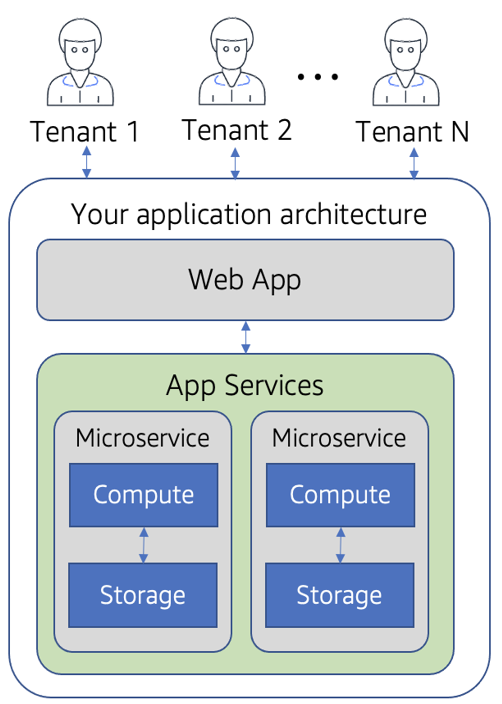Adding Tenancy to your Architecture
Let’s start our exploration of SaaS architecture concepts by looking at a traditional non-SaaS application. In classic applications, the environment is constructed from the ground up with the assumption that it will be installed and run by individual customers. Each customer essentially has its own dedicated footprint. Figure 2-1 provides a conceptual view of how one of these applications might be designed and built.

Figure 2-1. Traditional non-SaaS environments
On the left here, you’ll see that we have a simplified view of a class application. Here, this application is built and then sold to individual customers. These customers might install the software in their own environment or it might run in the cloud. This approach simplifies the entire architectural model of this environment. The choices about how customers enter the environment, how they access our resources, and how they consume the services of our environment are much simpler when we know that they will be running in an environment that is dedicated to each customer. The general mindset here is that you have a piece of software and you’re just stamping out copies of it for each new customer.
Now, let’s think about what it means to deliver this same application in a multi-tenant SaaS environment. The diagram in Figure 2-2 provides a conceptual view of what this might look like. You see here that our customers, which are now tenants, are all consuming the same application.

Figure 2-2. The shift to a tenant-centric experience
This shift may seem fairly simple in the diagram. However, it has a profound impact on how we design, build, secure, and manage this environment. We’ve essentially made the transition from a per customer dedicated model to a multi-tenant architecture. Supporting this model reaches into every dimension of the underlying implementation of your system. It affects how you implement authentication, routing, scaling, performance, storage, and, in targeted areas, how you code the application logic of your system.
As a SaaS architect and builder, it becomes your job to determine how your system will support this notion of tenancy. In some cases, the influence here may be introduced as an extension of existing patterns and strategies. In other cases, it may require you to build and design all new constructs that must be added to support the needs of a multi-tenant setting.
Part of the challenge here is that there’s a wide range of parameters that will influence how this notion of tenancy ends up landing in your environment. The key, at this stage, is to understand the fundamental architecture concepts and then look at how the different dimensions of your environment might influence how these concepts are expressed in a given environment. So, for the moment at least, let’s stay up a level from these environmental considerations and focus squarely on building an SaaS architecture foundation that will give us the terminology and taxonomy of constructs that we can use to characterize the different moving parts and mechanisms that should be in the vocabulary of every SaaS architect and builder.